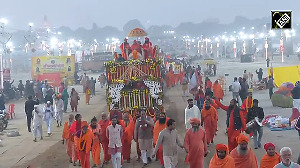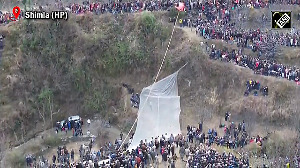.jpg?w=670&h=900) A well-known tag will help the brand crack down on those riding on its name
A well-known tag will help the brand crack down on those riding on its name
There is little that one does not know about Amul.
Its co-operative traditions, mass appeal and of course, the punchy advertising -- the brand not only has instant recall but is also associated with all things Indian. But success breeds copycats and today we have everything from innerwear to auto component companies naming themselves Amul.
Now, with the Intellectual Property Appellate Board giving Amul a well-known trademark the co-operative expects things to change.
Gujarat Co-operative Milk Marketing Federation’s managing director R S Sodhi welcomes the 'well known' trademark.
It will stop other companies that were cashing in on the brand’s popularity and Amul’s pan-India presence, he says.
The new status provides a brand with requisite legal muscle to come down on such companies. Will this lead to litigations in the future as Amul goes after other manufacturers using its name?
Sodhi feels it might.
For a brand that has worked hard to become the third most chosen brand in the country after Parle and Clinic Plus (IMRB-Kantor Brand Footprint survey), it would want to come down hard on those misusing the name.
The Controller-General of Patents Design & Trademarks, Department of Industrial Policy and Promotion, Union Ministry of Commerce and Industry, in a notification, approved and categorised Amul as a ‘well-known brand’ in a list of 68 brands which includes Coca Cola, Kodak, Wimbledon, Yahoo and Indian ones like Bata, Bajaj, Bisleri, Nirma and Infosys.
As a result, Amul is now part of a special category that is protected from copycats even outside the country of origin.
Also these names cannot be used by anyone else, even for dissimilar products.
It may be time therefore for entities like the Amul Group of Companies based out of Rajkot, which makes auto-components, to take heed.
Founded in 1988, the company makes connecting rods, crank shafts, cylinder blocks, cylinder heads and camshafts and is a vendor to several leading original equipment manufacturers.
Then there is Kolkata-based JG Hosiery that makes Amul branded innerwear.
Despite several attempts, both companies could not be contacted.
Harish Bijoor, brand expert and CEO of Harish Bijoor Consults says, “Any company which copies a popular brand name basically wants to ride on the brand equity of that already popular brand. It gives them a quick awareness and recall.
"They, however, know that this is short-lived.”
Bijoor feels that despite the hosiery company or for that matter any other firm that has copied Amul’s brand name having to rework their branding strategy, no significant impact on consumer preference is expected.
“When they ride on another brand’s recall, they want to quickly ride the popularity wave. But end of the day, the consumer would evaluate the product they offer.”
Also, these companies may already have achieved what they sought to do.
Having used the Amul brand to connect with the customer, even if they were to stop using the name, the consumer may still buy their products, provided, of course, their quality is not an issue.
Bijoor says, “The window of time that these companies buy before they are stopped legally from using a popular brand name does the trick for them.”
It is the power and history of a brand that copycat companies like these hope to cash in on.
Amul has dollops of both.
When it was first created, the legendary Verghese Kurien looked for a name that was ‘Indian’.
He deliberately ignored the advice of consultants who suggested that they use a name with ‘foreign’ ring given that they were looking to wrest market share from Polson, the then top selling brand which was allegedly exploiting farmers by procuring milk at very low rates.
Amul is the short form for Anand Milk Union Ltd.
Soon Amul became more than just a milk and butter brand and is today used as an umbrella for all the products that GCMMF markets.
Sodhi recollects, “In those days, India was a milk-deficit country. Milk powder was imported.” From a per capita consumption of 110 grams per person to over 300 grams per person, the country’s dairy industry has come a long way, and Gujarat’s Amul has indeed had a big role to play in that.
Sodhi also highlights another milestone.
In the 1990s we came up with the tagline of “Taste of India”, and it basically captures the brand’s pan-India presence and the essence of nationalism that Kurien wanted to be a part of the dairy movement.
As a brand Amul has not changed its mascot and communication, sticking with the original look and keeping its focus on topical issues over the years.
According to Rahul daCunha, managing director and creative head, daCunha Communications, many brands try something new even when it is not required.
“We have not changed the Amul Girl, and the topicals around it. And it has worked for so many years, and not just that, it is one of those homegrown brands that have been able to carve a niche and hold its own amidst a flurry of foreign brands”.
For the Rs 21,000-crore (Rs 210-billion) GCMMF, now selling across 50 countries, being well-known is nothing new; but it does feel good to have the world know that.
Image: The Amul girl. Photo courtesy, Amul

.jpg)









 © 2025 Rediff.com -
© 2025 Rediff.com -